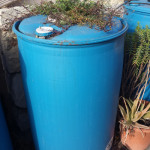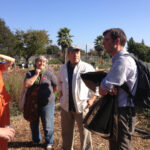Living with Climate Change
 originally published by Transition Culture
originally published by Transition Culture
No water. That pretty much sums up living with climate change around here, in Los Angeles. California is currently experiencing “the worst drought in 500 years.” We had one minor “rain event” in October just before Rob Hopkins came to town, and another minor rain event in late January. Up until this week, we’d had 1.02 inches of rainfall since last July, instead of our normal 15 inches. So much for our so-called “rainy season.”
As I write this, we’re experiencing an extraordinarily severe “biggest rainstorm in two years” (which may bring our total annual rainfall up to 3 inches, approximately the level of a prior “record drought”). Soon we’re headed into what are traditionally our dry months. In a normal year, zero rain typically falls between May and November.
Water wars
Up until this past week, statewide reservoir lakes were at an all-time low, and the mountain snowpack which should fill those reservoirs was at 12% of normal. Note that isn’t “down by 12%”. It is at 12%, which means down by 88%. Even with the current freak storm, the water situation continues to be very grave.
Some towns in California are now running out of water. Political debates are already underway between state agriculture versus city populations over who gets what water there is.
Agriculture is already affected. Some farmers have reduced their plantings; ranches are selling off livestock. Big parcels of land are going unplanted — not even with cover crops. Although we have not yet had Dust Bowl-style winds, the agricultural situation is the perfect setup for massive-scale topsoil loss.
A recent infographic warned the nation that extreme-to-exceptional drought in California will mean supply and pricing issues for 15 key foods. California produces 90 to 99% of U.S. almonds, walnuts, broccoli, strawberries, and tomatoes.
Next-to-no-rain means that deep-rooted trees and perennials in areas without artificial irrigation aren’t getting sufficient water this year. Some large plants will likely be lost. Others are probably ripe for massive onslaughts of pests and diseases, as has happened in previous (lighter) drought years.
In 2014, we’ve already had wildfires. Up until this decade, fires in January were pretty much unheard of (and I’ve lived in this area all my life). When our “normal” fire season arrives this summer and autumn, it’s going to be truly horrific around here.
In the meantime, this week’s freak rain storm is causing flooding, mudslides, mandatory evacuations, and property destruction as stormwaters rush unbounded through areas that suffered last year’s firestorms.
In our home gardens
At garden gatherings around L.A., everyone is noticing changes in seasonality. Tomatoes are over-wintering, summer crops are sprouting months early, fruit trees are flowering at odd times, and there are massive pest attacks on our normal winter crops like broccoli and kale.
Already we’re threatened by the rapid spread of nonnative pests, such as an Asian psyllid which carries a plant disease Huanglongbing deadly to citrus trees, and the glassy-winged sharpshooter which spreads the disease-causing bacterium Xylella fastidiosa, which kills grape vines.
Soil fertility will likely be troublesome this summer, since irrigation solely with our alkaline tapwater intensifies the pre-existing alkalinity of our soils. It will be a continual battle to add more-acidic material to our soils to bring them into the range that vegetable plants like.
If summer months bring any form of water rationing, our nascent urban agriculture is woefully unprepared. Most veg gardens here are set up on the paradigm of English or U.S. East Coast gardens, with raised beds and water-intensive vegetable selections, rather than the waffle-style gardens and drought-tolerant varieties we should be using.
Status quo continues
The vibe around town is that people have been highly aware of the lack of rain. Yet there still seems to be little in the way of large-scale, mainstream, emissions-reducing habit shift. No change in the social glamor of air travel, no inclination to eliminate unnecessary car trips. There are still very few people who acknowledge the ties between globalized chainstore consumerism and global warming emissions.
Despite the drought, lawns in my neighborhood are still unnaturally green (that means they’re still being irrigated) and gutters often run with water wasted by sprinkler overspray. The California governor has asked for 20% decrease in water use, but politicians are insisting that it be voluntary participation, rather than mandatory rationing. And there has been no progress on expanding any permissions for on-site greywater.
Studies the end of last year revealed that media reporting of Weird Weather events carefully dodge any connection to human-caused climate change and global warming. Locally, the deniers have adjusted their soundbites, from denying global warming is happening, to denying that it is human-caused, or denying that our 500-year drought is related. (Nationally, with Weird Weather taking a turn toward deep freeze, global warming deniers are having a heyday.)
Many people will undoubtedly look to this week’s freak rainstorm and presume it “solved” the drought; most are blissfully unaware of the scale necessary to deliver water to 11 million people. “California is running out of options to deal with the fact that it has basically been relying on more water than it has long-term access to,” warns David Hayes, a former U.S. Interior Department official. Yet most people still don’t get it.
Through it all, L.A. is continuing to expand freeways, continuing the debate over how to expand LAX airport, and trying to figure out how to “grow” the stalled economy.
The welling-up of meaningful action
In our Transition groups (and in oh-so-many groups that are not labeled as “Transition”) there has been a surge of interest in growing food. Water-wise food gardening and rainwater harvesting are highly-requested speaking topics. It feels to me as if people are insecure and “sense” that deeper troubles are coming.
In the poorer areas of town, I observe a lot more bicycling being used as transportation, but I’m guessing this is due to the price of gasoline and ongoing economic troubles (a recent study found that 27% of L.A. County residents live below the poverty line).
Beneath the headlines on local events, I’m seeing subtle shifts in the organizations themselves. Organizations which weren’t founded for environmental or climate-based issues, are now folding these topics into their descriptions of why they do what they do.
Organizations that never before were about environmental action are putting in place programs which could definitely qualify as “transition”-style projects, such as a local church diocese encouraging all of its church properties to grow food gardens, and a local art college setting up a Minor in Sustainability (which I am thrilled to mentor).
L.A. City is poised to ban fracking. A larger nonprofit is creating sweeping goals for the region for 2050, which reach beyond economic measurements, and in many cases overlap with what we might call “transition indicators.”
And through it all, L.A. has the heroic Andy Lipkis, who seems to be single-handedly barging forward with a paradigm-shifting way to overhaul L.A.’s water infrastructure which involves making wise use of what rainwater we do get. With the connections Andy has built around the city, particularly within city politics, if anyone can achieve this mighty goal, that person is Andy Lipkis.
But ultimately, when it comes to Living with climate change, we have to come back to that Living part. To me this means the quality of our lives and our connections, as we all weather this Wacky Weather together.
Earlier this month, our group helped host Seed School, a 7-day exploration of all things related to heirloom vegetable seeds. We shared marvelous information, but even moreso, the gathering grew astounding connections. Some people were doing seed-related activities for social justice, hunger, and poverty reasons. Others were doing it for education and kids reasons. Still others had ecological and biodiversity as their drivers. But altogether, this was a shining example of common action, collaboration across the miles, and the realization that, all over Southern California, there are so many people DOING really great stuff, which is all contributing to a new energy, a new culture, a new way of looking at life. That is living with climate change right now in Los Angeles.



